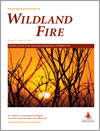International Journal of Wildland Fire
Volume 23
Number 3 2014
The scientific basis for wildland firefighter safety zone guidelines is summarised. Experimental and theoretical studies are reviewed. Current understanding is evaluated within the context of a selection of wildland fire entrapments. Recommendations are presented for additional work needed to more completely address the question of what constitutes an effective wildland firefighter safety zone.
Daily values of fire danger for Tasmania, Australia, were generated using a regional climate model at ~10-km resolution, for 1961–2100. Regional and seasonal changes in the occurrence of high fire danger were evident over time, and days with pressure patterns associated with high fire danger became more frequent.
This study explores four metrics to describe both widespread fire years and potentially extreme individual fires derived from a case study of wildland fires from 1984 to 2009 in the north-western United States. A combination of percentile-based thresholds is used for each of the metrics to define individual fires as extreme events.
A methodology to obtain isochrones at different stages of a wildfire through temporal georeferencing of aerial fire photographs is proposed. This methodology has been applied to two large wildfires (1098 and 4609 ha) that occurred in Spain. This study revealed a rate of propagation much higher than expected.
We evaluated the potential use of very low-density airborne LiDAR data (0.5 first returns m–2), which is freely available for most of the Spanish territory, to estimate canopy fuel characteristics in Pinus radiata stands in north-western Spain.
Forest floor (litter, fermentation and humus) load, composition, depth, bulk density and mineral content were studied in Jeffrey pine–white fir forests. Forest floor fuels varied spatially in relation to distance from tree boles. The structural and compositional diversity in these fuels underscores our need to better understand forest floor fuels.
The role of forest fuel management for wildfire prevention in Spain was assessed by means of a quantitative SWOT (Strengths, Weaknesses, Opportunities and Threats) analysis. Existing obstacles hindering the implementation of effective fuel management are identified and preliminary recommendations are provided to overcome them.
Visual fuel assessments can be used to parameterise fire behaviour models. Vesta visual fuel assessments in eucalypt woodlands were strongly correlated with quantitative measurements, indicating that visual assessments adequately captured time-since-fire changes in fuel. Issues limiting the wider application of the Vesta methodology were mainly associated with differences between communities in their responses to fire.
Central Australia has experienced many large summer fires over the past five to six decades. However, over the last two decades increased rainfall promoted herbs and soft grasses and resulted in higher fire frequency. This study documents the relationship between fire return interval and mulga regeneration.
In the Canary Islands, wildfires are recurrent in pine forests, and have been reported by the media as an ecological disaster. We investigated fire effect on vegetation and soil nutrients in a well-preserved Canarian pine forest. Results indicated positive effects of fire, such as increased soil organic matter and forest regeneration 4 years after fire.
In tropical grasslands and savannas, fire is used to reduce woody vegetation expansion. Woody vegetation in these biomes is often patchily distributed with unknown consequences for fire effects. Tree seedlings at the leeward side of wooded patches were less affected by fire, suggesting a ‘safe zone’ promoting woody vegetation expansion.
Fire has been excluded from many high elevation sagebrush communities because of current management policies. Fire, however, may be important in these ecosystems. We found that fire creates spatial and temporal heterogeneity in soil nutrients, arthropods and plant diversity. This suggests that fire exclusion may have some negative effects and that management may need to include infrequent fire.
The aim of the study was to investigate, using the canopy chamber method, the effect of fire on the recovery of grassland vegetation in terms of C fluxes from and to the ecosystem. Two years of investigation showed that the grassland under study can recover quite quickly after fire, although the dynamics of recovery are largely dependent on water availability.
This study explores the evacuation preferences of Flathead County, Montana, US residents at risk from wildfire. We found differences in the performance of vegetation management among residents who plan to evacuate or remain at home. Evacuation preferences can be partially explained by characteristics such as demographics.
The results of a field experiment for grass fire propagation and the effects on wooden constructions and peat layers are provided. Fire characteristics and conditions for wooden construction ignition are investigated. Practical recommendations are given to minimise the probability of grass fires spreading to wooden constructions.




